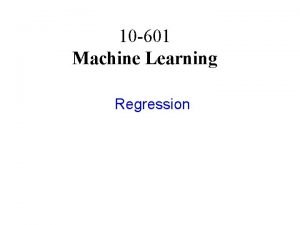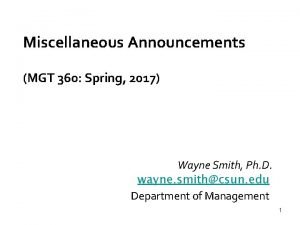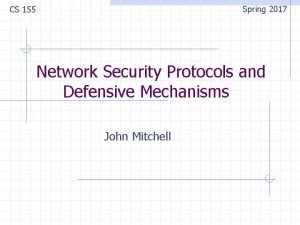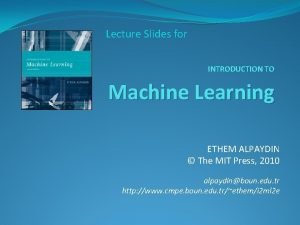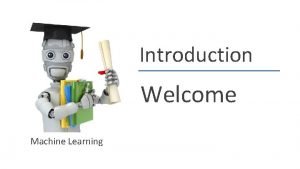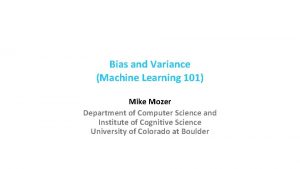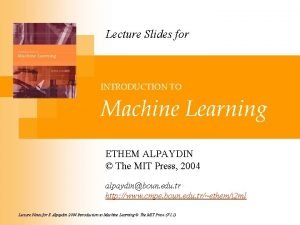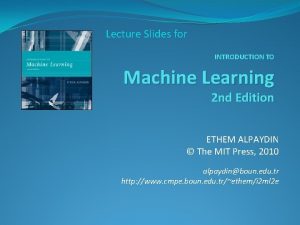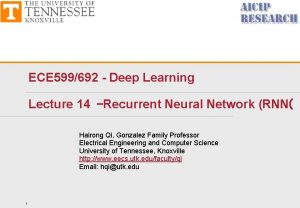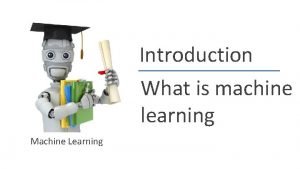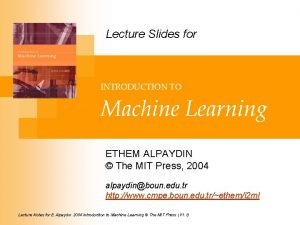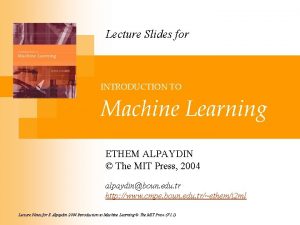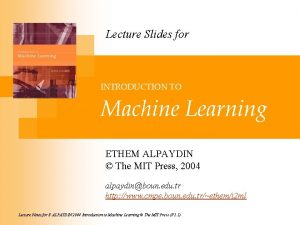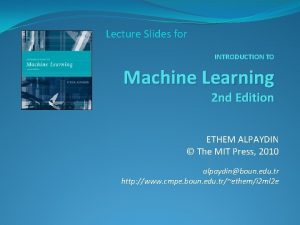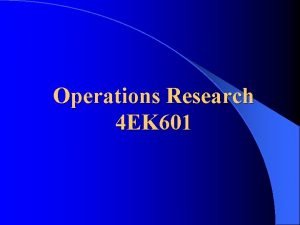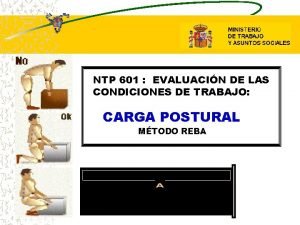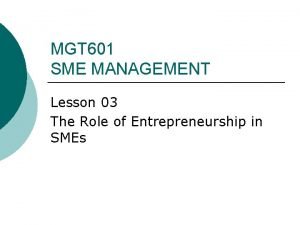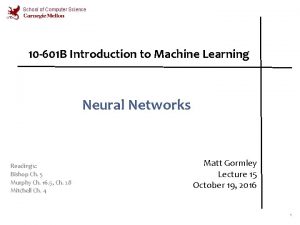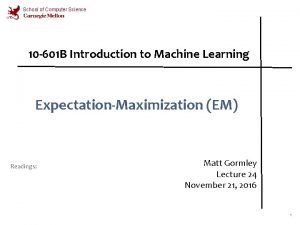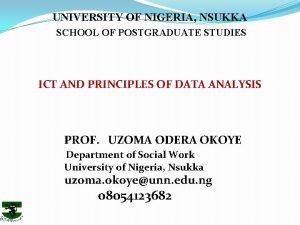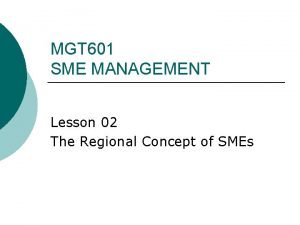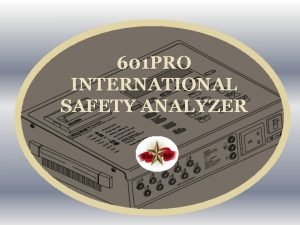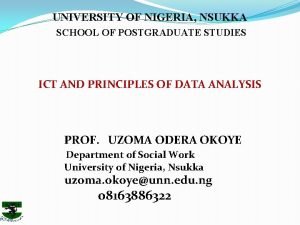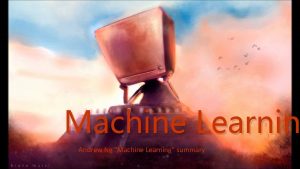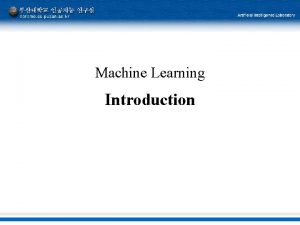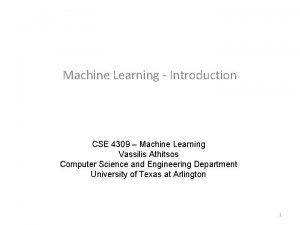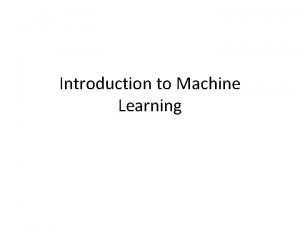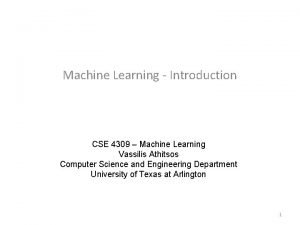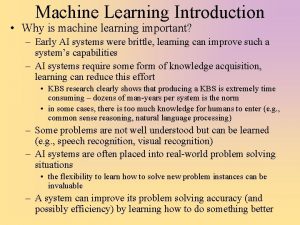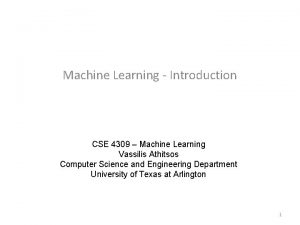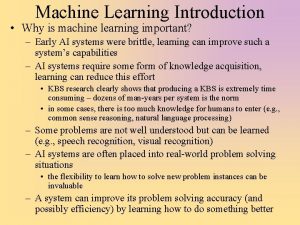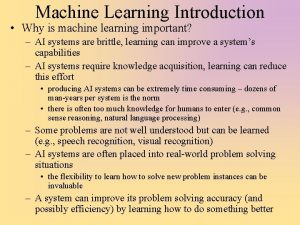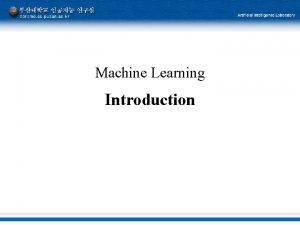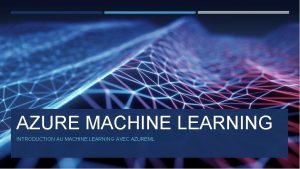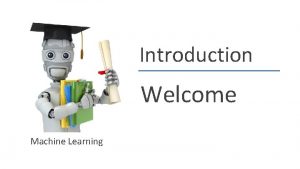Machine Learning An introduction 10 601 Spring 2017














































- Slides: 46

+ Machine Learning: An introduction 10 -601 Spring 2017

+ Machine learning is about learning from DATA!

+ n Learning from data THE WORLD IS DRIVEN BY DATA n ? 1 Trillion web pages n 1 hour of video is uploaded to Youtube every second 10 years of content every day n Germany’s climate research center generates 10 petabytes per year (1 petabyte = 1 million gigabytes) n Google processes 24 petabytes per day n There are over 50 m credit card transactions a day in the US alone

+ Learning from data n Data is recorded from some real-world phenomenon n What might we want to do with that data? n n Prediction n What can we predict about this phenomenon? Description n How can we describe/understand this phenomenon in a new way?

+ Learning from data n How can we extract knowledge from data to help humans take decisions? n How can we automate decisions from data? n How can we adapt systems dynamically to enable better user experiences? Write code to explicitly do the above tasks Write code to make the computer learn how to do the tasks

+ Machine Learning Machine learning is a set of methods that can automatically detect patterns in data and then use the uncovered patterns to predict future data, or to perform other kinds of decision making under uncertainty (such as planning how to collect more data !) Kevin P. Murphy

+ Machine learning self-configuring data structures that allow a computer to do things that would be called “intelligent” if a human did it

+ Machine learning Programs that improve through experience Tom Mitchell, 1997

+ Machine learning Programs that improve through experience Tom Mitchell, 1997 n Programs: automated procedures implemented on a computer n Improve? n n What? n Their performance Task we want to learn Task? n Anything you want a computer to do for your

+ Task n Playing chess n making predictions n making decisions or actions

+ Why not programming it directly? why learning?

+ Why not programming? n Driving a car n Recognizing spam emails n Recommendation books n Reading handwriting n Recognizing speech, faces, etc How would you write these programs? Would you want to? !? !?

+ Why not programming? n Many applications are immensely hard to program directly. n These are almost always turn out to be “pattern recognition” tasks. Program the computer to be able to learn from examples.

+ Why learn? n We would like computers to optimize a performance criterion using example data or past experience. n There is no need to “learn” to calculate payroll n Learning n n is used when: Human expertise does not exist (navigating on Mars), Humans are unable to explain their expertise (speech recognition) Solution changes in time (routing on a computer network) Solution needs to be adapted to particular cases (user biometrics) 14

+ Traditional Programming Data Program Computer Output Computer Program Machine Learning Data Output

+ Performance n How do we know that it gets better? n Convert “doing well” into a measurable criterion n Example: n In a chess game: the % of games won n What about speech recognition? n Or machine translation?

+ Machine learning and AI n Humans can: n think, learn, see, understand language, reason, etc. n Artificial Intelligence aims to reproduce these capabilities. n Machine Learning is one part of Artificial Intelligence. n Other areas of AI: n n Knowledge representation Reasoning Logical deduction …

+ Machine Learning n Where does it fit? What is it not? Statistics / Mathematics Artificial Intelligence Data Mining Computer Vision Robotics Machine Learning

+ Example: face and expression identification

+ Identify vocal patterns and speech processing

+ ML is everywhere n ML for working with social network data: n n detecting fraud, marketing Managing ads in your Facebook page: profiling computer games route finding, biology

+ ML is hard! You See

+ ML is hard! You See Your ML program Sees

+ ML is hard!

+ ML is hard! n Most of the applications are immensely hard to program directly. n These almost always turn out to be“pattern recognition” tasks. 1. Program the computer to do the pattern recognition task directly 2. Program the computer to be able to learn from examples n Provide ” training” data

+ How does a machine learn? Step 1: split the data into train and test sets

+ How does a machine learn? Step 2: build a model on a training set

+ How does a machine learn? Step 3: evaluate on a test set

+ n Supervised n n Unsupervised n ML approaches n You know what the outcome must be You don’t know what the outcome must be Semi-Supervised n You know the outcome only for some examples

+ Approaches Supervised learning Unsupervised learning Semi-supervised learning

+ Supervised learning

+ Supervised learning 1) Training a model 2) Testing a model

+ Supervised Learning • Detection of spam emails To: you@gmail. com GET YOUR DIPLOMA TODAY! If you are looking for a fast and cheap way to get a diploma, this is the best way out for you. Choose the desired field and degree and call us right now: For US: 1. 845. 709. 8044 Outside US: +1. 845. 709. 8044 "Just leave your NAME & PHONE NO. (with Country. Code)" in the voicemail. Our staff will get back to you in next few days!

+ Loan application approval n Two classes: n Yes n No

+ Loan application approval What is the class for following case/instance?

+ Unsupervised Learning

+ Unsupervised Learning • Book recommendation

+ Image processing

+ Improving IR Recall n Cluster hypothesis - Documents with similar text are related n Thus, when a query matches a document D, also return other documents in the cluster containing D.

+ Skyserver n A cool to map the universe n Clustered 2*109 sky objects into similar objects: n stars n galaxies n quasars n etc.

+ ML popularity

+ ML in Google: “The cat neuron” n Andrew Ng et al. , n 1000 Machines n 10 Million images n Train for 3 days n Recognize cats in youtube videos n Correctly captioned a photo of “a group of young people playing Frisbee” http: //research. google. com/archive/unsupervised_icml 2012. html

+ n ML in Facebook Yen Le. Cunn Director od AI research at Facebook n Ask their program what it sees in the image n “Is there a baby? ” n n “What is the man doing? ” n n Facebook: “Yes” Facebook: “Typing” “Is the baby sitting on his lap? ” n “yes” http: //www. wired. com/2015/11/heres-how-smart-facebooks-ai-has-become/

+ http: //www. youtube. com/watch? v=NS_L 3 Yyv 2 RI ML in Microsoft

+ When would we use ML? n When n patterns exist in our data Even if we don’t know what they are n We cannot pin down the functional relationships mathematically n else we would just code up the algorithm n When we have lots of (unlabeled) data Labeled training sets harder to find n Data is of high dimension (bench of features) n example: sensor data n

+ If you want to be a Data Scientist g n i d o C ills Sk Software Engineer Ma Data Science £££ Statistician Specialist Domain Knowledge /S cs tatis ow ti led ge Kn Machine Learning ths
 Linear regression loss function
Linear regression loss function Wayne smith csun
Wayne smith csun Ftp server spring 2017
Ftp server spring 2017 Cast of spring, summer, fall, winter... and spring
Cast of spring, summer, fall, winter... and spring Autumn winter months
Autumn winter months Concept learning task in machine learning
Concept learning task in machine learning Analytical learning in machine learning
Analytical learning in machine learning Pac learning model in machine learning
Pac learning model in machine learning Machine learning t mitchell
Machine learning t mitchell Inductive vs analytical learning
Inductive vs analytical learning Inductive and analytical learning
Inductive and analytical learning Instance based learning in machine learning
Instance based learning in machine learning Inductive learning machine learning
Inductive learning machine learning First order rule learning in machine learning
First order rule learning in machine learning Eager learner and lazy learner
Eager learner and lazy learner Deep learning vs machine learning
Deep learning vs machine learning Introduction to machine learning ethem alpaydin
Introduction to machine learning ethem alpaydin What is unsupervised learning algorithm
What is unsupervised learning algorithm Andrew ng introduction to machine learning
Andrew ng introduction to machine learning Mike mozer
Mike mozer Machine learning ethem
Machine learning ethem Cmu machine learning
Cmu machine learning Introduction to machine learning slides
Introduction to machine learning slides Introduction to machine learning and data mining
Introduction to machine learning and data mining A friendly introduction to machine learning
A friendly introduction to machine learning Andrew ng introduction to machine learning
Andrew ng introduction to machine learning Ethem alpaydin
Ethem alpaydin Introduction to machine learning ethem alpaydin
Introduction to machine learning ethem alpaydin Introduction to machine learning ethem
Introduction to machine learning ethem Machine learning lecture notes
Machine learning lecture notes Jaynell pittman
Jaynell pittman Ek601
Ek601 Metodo reba ntp
Metodo reba ntp Mgt 601
Mgt 601 Http 601
Http 601 Nr 601 test bank
Nr 601 test bank Backpropagation logistic regression
Backpropagation logistic regression 601(b)(10)
601(b)(10) Pgc 601
Pgc 601 Sme management definition
Sme management definition Pgc 601
Pgc 601 Deffibrilator
Deffibrilator Pgc 601
Pgc 601 Peugeot 601 eclipse
Peugeot 601 eclipse Tcp 601
Tcp 601 Hino 601
Hino 601 601(b)(10)
601(b)(10)
